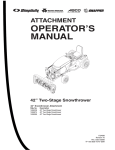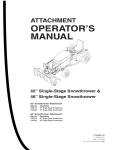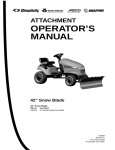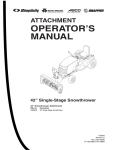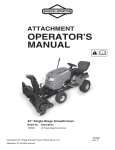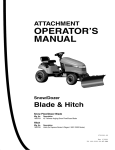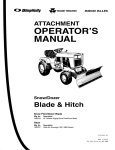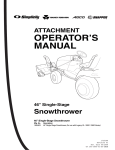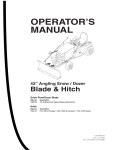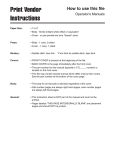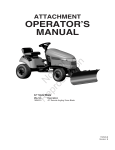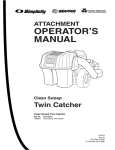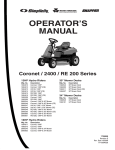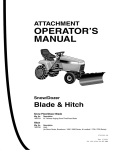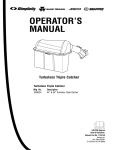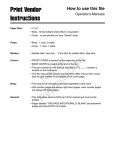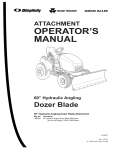Download Simplicity 1694399 Lawn Mower User Manual
Transcript
ATTACHMENT OPERATOR’S MANUAL 47” Two-Stage Snowthrower 47” Two-Stage Snowthrower Mfg. No. 1694404 Description 47” Two Stage Snowthrower (for use with Legacy LX / 2000 / 2900 Series) 1725463 Revision 05 Rev. Date 04/2008 TP 100-3897-05-AT-SMAN www.simplicitymfg.com www.snapper.com Briggs & Stratton Power Products Group, L.L.C. Copyright © 2008 Briggs & Stratton Corporation Milwaukee, WI USA. All Rights Reserved www.BRIGGSandSTRATTON.com www.MasseyLawn.com Table of Contents Adjustment Skid Shoe Adjustment ...................................11 Safety Rules & Information Training ............................................................2 Preparation ......................................................2 Operation.........................................................2 Children ...........................................................3 Clearing a Clogged Discharge Chute ..............3 Service, Maintenance and Storage .................3 Emissions ........................................................3 Decals..............................................................4 Required Accessories...................................5 Recommended Accessories.........................5 Clean-Out Warning and Procedure ..............5 Troubleshooting, Adjustments & Service Troubleshooting Chart ...................................12 Initial Installation Install Front Hitch...........................................13 Install Long Drive Shaft .................................14 Mount Cable Guide........................................15 Assemble Discharge Chute ...........................15 Electric Chute Rotator ...................................15 Attach Short Drive Shaft to Drive Chain Box.............................................16 Secure Cables ...............................................16 Check Auger Gear Box Oil Levels .................16 Snowthrower Installation................................17 Operation Controls ...........................................................7 Checks Before Starting....................................7 Operating on Slopes........................................7 Transporting.....................................................8 Engine & Ground Speed Selection..................8 Stopping & Starting .........................................8 Snow Removal Suggestions............................8 Daily Storage ...................................................8 . Off Season Storage .........................................8 Snowthrower & Hitch Removal Snowthrower & Hitch Removal ......................19 Mounting Remote Deflector Control Instructions ....................................................20 Template ........................................................21 Maintenance Schedule for Normal Care ...............................9 Lubricate Snowthrower ....................................9 Lubricate Discharge Chute ............................10 Drive Shaft Lubrication ..................................10 Lubricate Auger Shaft....................................10 Check Auger Gearbox Oil Level ....................10 Lubricate Discharge Chute Drive Chain ........10 Inspect Scraper Bar.......................................11 Reversing Scraper Bar ..................................11 Shear Bolts ....................................................11 Hardware Torque Specifications Chart..............................................................22 NOTE: In these instructions, “left” and “right” are referred to as seen from the operating position. 1 Safety Rules & Information This machine is capable to amputating hands and feet. Read these safety rules and follow them closely. Failure to obey these rules could result in loss of control of unit, severe personal injury or death to you, or bystanders, or damage to property or equipment. The triangle in text signifies important cautions or warnings which must be followed. TRAINING OPERATION 1. Read, understand, and follow all instructions on the machine and in the manuals before operating this unit. Be thoroughly familiar with the controls and the proper use of the equipment. Know how to stop the unit and disengage the controls quickly. 2. Never allow children to operate the equipment. Never allow adults to operate the equipment without proper instruction. 3. Keep the area of operation clear of all persons, particularly small children and pets. 1. Do not put hands or feet near or under rotating parts. Keep clear of the discharge opening at all times. 2. Exercise extreme caution when operating on or crossing gravel drives, walks, or roads. Stay alert for hidden hazards or traffic. Do not carry Passengers. 3. After striking a foreign object, stop the engine (motor), remove the wire from the spark plug, disconnect the cord on electric motors, thoroughly inspect the snowthrower for any damage, and repair the damage before restarting and operating the snowthrower. 4. If the unit should start to vibrate abnormally, stop the engine (motor) and check immediately for the cause. Vibration is generally a warning of trouble. 5. Stop the engine (motor) whenever you leave the operating position, before unclogging the collector/impeller housing or discharge guide, and when making any repairs, adjustments, or inspections. 6. When leaving the machine unattended, disengage the power take-off (PTO), lower the attachment, set the parking brake, stop the engine, and remove the key. 7. When cleaning, repairing, or inspecting make certain the collector/impeller and all moving parts have stopped. Disconnect the spark plug wire and keep the wire away from the plug to prevent accidental starting. Do not run the engine indoors except for starting the engine or for transporting the snowthrower in or out of the building. Open the outside doors; exhaust fumes are dangerous. 8. Exercise extreme caution when operating on slopes. Do not attempt to clear steep slopes. 9. Never operate the snowthrower without proper guards plates, or other safety protective devices in place and working. 10. Never direct the discharge toward people or areas where property damage can occur. Keep children and others away. 11. Do not overload the machine capacity by attempting to clear snow at too fast a rate. 12. Never operate the machine at high transport speeds on slippery surfaces. Look behind and use care when operating in reverse. 13. Disengage power to the collector/impeller when snowthrower is transported or not in use. 14. Use only attachments and accessories approved by the manufacturer of the snowthrower (such as wheel weights, counterweights, or cabs). 15. Never operate the snowthrower without good visibility or light. Always be sure of your footing, and keep a firm hold on the handles. Walk, never run. 16. Never touch a hot engine or muffler. 17. Never operate the snowthrower near glass enclosures, automobiles, window wells, drop-offs, and the like without proper adjustment of the discharge angle. 18. Never direct discharge at bystanders or allow anyone in front of the unit. 19. Never leave a running unit unattended. Always disengage the auger and traction controls, stop engine, and remove keys. PREPARATION 1. Thoroughly inspect the area where the equipment is to be used and remove all doormats, sleds, boards, wires, and other foreign objects. 2. Disengage all clutches and shift into neutral before starting engine (motor). 3. Do not operate the equipment without wearing adequate winter outer garments. Avoid loose fitting clothing that can get caught in moving parts. Wear footwear that will improve footing on slippery surfaces. 4. Handle fuel with care; it is highly flammable. (a) Use an approved fuel container. (b) Never add fuel to a running engine or hot engine. (c) Fill fuel tank outdoors with extreme care. Never fill fuel tank indoors. Replace fuel cap securely and wipe up spilled fuel. (d) Never fill containers inside a vehicle or on a truck or trailer bed with a plastic liner. Always place containers on the ground, away from your vehicle, before filling. (e) When practical, remove gas-powered equipment from the truck or trailer and refuel it on the ground. If this is not possible, then refuel such on a trailer with a portable container, rather than from a gasoline dispenser nozzle. (f) Keep nozzle in contact with the rim of the fuel tank or container opening at all times, until refueling is complete. Do not use a nozzle lock-open device. (g) Replace gasoline cap securely and wipe up spilled fuel. (h) If fuel is spilled on clothing, change clothing immediately. 5. Adjust the collector housing height to clear gravel or crushed rock surfaces. 6. Never attempt to make any adjustments while the engine (motor) is running (except when specifically recommended by the manufacturer). 7. Let engine (motor) and machine adjust to outdoor temperatures before starting to clear snow. 8. Always wear safety glasses or eye shields during operation or while performing an adjustment or repair to protect eye from foreign objects that may be thrown from the machine. TP-600-4159-00-UV-SMAN 2 Safety Rules 20. Do not operate the unit while under the influence of alcohol or drugs. 21. Keep in mind the operator is responsible for accidents occurring to other people or property. 22. Data indicates that operators, age 60 years and above, are involved in a large percentage of power equipment-related injuries. These operators should evaluate their ability to operate the unit safely enough to protect themselves and others from injury. 23. DO NOT wear long scarves or loose clothing that could become entangled in moving parts. 24. Snow can hide obstacles. Make sure to remove all obstacles from the area to be cleared. 8. Always follow the engine manual instructions for storage preparations before storing the unit for both short and long term periods. 9. Always follow the engine manual instructions for proper start-up procedures when returning the unit to service. 10. Maintain or replace safety and instruction labels as necessary. 11. Keep nuts and bolts tight and keep equipment in good condition. 12. Never tamper with safety devices. Check their proper operation regularly and make necessary repairs if they are not functioning properly. 13. Components are subject to wear, damage, and deterioration. Frequently check components and replace with manufacturer’s recommended parts, when necessary. 14. Check control operation frequently. Adjust and service as required. 15. Use only factory authorized replacement parts when making repairs. 16. Always comply with factory specifications on all settings and adjustments. 17. Only authorized service locations should be utilized for major service and repair requirements. 18. Never attempt to make major repairs on this unit unless you have been properly trained. Improper service procedures can result in hazardous operation, equipment damage and voiding of manufacturer’s warranty. 19. Check shear bolts and other bolts at frequent intervals for proper tightness to be sure the equipment is in safe working condition. CHILDREN Tragic accidents can occur if the operator is not alert to the presence of children. Children are often attracted to the unit and the operating activity. Never assume that children will remain where you last saw them. 1. Keep children out of the area and under the watchful care of another responsible adult. 2. Be alert and turn unit off if children enter the area. 3. Never allow children to operate the unit. 4. Use extra care when approaching blind corners, shrubs, trees, or other objects that may obscure vision. CLEARING A CLOGGED DISCHARGE CHUTE Hand contact with the rotating impeller inside the discharge chute is the most common cause of injury associated with snowthrowers. Never use your hand to clean out the discharge chute. To clear the chute: 1. SHUT OFF THE ENGINE. 2. Wait 10 seconds to be sure the impeller blades have stopped rotating. 3. Always use a clean out tool, not your hands. EMISSIONS 1. Engine exhaust from this product contains chemicals known, in certain quantities, to cause cancer, birth defects, or other reproductive harm. 2. If available, look for the relevant Emissions Durability Period and Air Index information on the engine emissions label. SERVICE, MAINTENANCE, AND STORAGE 1. Check shear bolts and other bolts at frequent intervals for proper tightness to be sure the equipment is in safe working condition. 2. Never store the machine with fuel in the fuel tank inside a building where ignition sources are present such as hot water and spacer heaters, or clothes dryers. Allow the engine to cool before storing in any enclosure. 3. Always refer to the operator’s manual for important details if the snowthrower is to be stored for an extended period. 4. Maintain or replace safety and instruction labels as necessary. 5. Run the machine a few minutes after throwing snow to prevent freeze-up of the collector/impeller. 6. If fuel is spilled, do not attempt to start the engine but move the machine away from the area of spillage and avoid creating any source of ignition until fuel vapors have dissipated. 7. Always observe safe refueling and fuel handling practices when refueling the unit after transportation or storage. 3 Safety Decals SAFETY DECALS All DANGER, WARNING, CAUTION and instructional messages on your unit should be carefully read and obeyed. Personal bodily injury can result when these instructions are not followed. The information is for your safety and it is important! The safety decals below are on your unit. This unit has been designed and manufactured to provide you with the safety and reliability you would expect from an industry leader in outdoor power equipment manufacturing. Although reading this manual and the safety instructions it contains will provide you with the necessary basic knowledge to operate this equipment safely and effectively, we have placed several safety labels on the unit to remind you of this important information while you are operating your unit. If any of these decals are lost or damaged, replace them at once. See your local dealer for replacements. These labels are easily applied and will act as a constant visual reminder to you, and others who may use the equipment, to follow the safety instructions necessary for safe, effective operation. Part No. 1709688 Auger Danger Decal Part No. 1722674 Discharge Chute Danger Decal DANGER AVOID INJURY FROM ROTATING AUGER! 1716532 Keep hands, feet, and clothing away. Part No. 1716532 Auger Danger Decal Part No. 1709689 Auger Danger Decal CAUTION WHEN OPERATING WITH SNOWTHROWER, REAR WHEEL WEIGHTS ARE REQUIRED. 1716540 Part No. 1716540 Wheel Weights Required Decal WARNING TO AVOID SERIOUS INJURY OR DEATH • Refer to Operator's Manual for Safety and Operating Instructions. • Keep all guards and shields in place. • Stop engine, remove key, and be sure all moving parts have come to a complete stop before servicing or unplugging. • Do not use hands to unplug chute or auger. • Always direct discharge so as to avoid injury to persons —or damage to property. • Never allow anyone in front of the machine while it is operating. 1716531 Part No. 1716531 Main Operation Warning Decal 4 Safety Information Required Accessories It is required that tire chains and two rear wheel weights or Quick Tach Weights are used. Never operate on slopes greater than 17.6% (10°). Recommended Accessories A rear-mounted weight box can also be added for additional traction. The maximum weight added to the tractor should not exceed 35 lbs. per wheel, plus 100 additional pounds in the rear weight box. For operation on slopes greater than 15% (8.5°), Quick Tach Weights, tire chains, and wheel weights are recommended. Never operate on slopes greater than 17.6% (10°). Required Accessories A Lift Lever Kit is required for some of the models covered by this manual, and must be installed as part of hitch installation. DANGER Do not clean out discharge chute with hands. Contact with moving parts inside chute will cause serious injury. Use a clean out tool. Use the following procedure to remove objects or clear the chute: 1. Stop the engine. Remove the key 2. Wait 10 seconds to be sure the auger/impeller blades have stopped rotating. 3. Always use a clean-out tool. DO NOT use your hands. TRACTOR CONTROLS Before you begin operating the tractor and attachment, make certain you have: • Read and understood the instructions in the tractor Operator’s Manual. • Become thoroughly familiar with all of the tractor controls and their operation, including how to safely and properly start and stop the unit. • Practice driving in an open area, without the attachment, to become accustomed to the unit. 5 6 Operation OPERATION Controls A E Read and understand the instructions in your tractor Operator’s Manual. C G Refer to Figure 1 for control locations. A. ELECTRIC CHUTE ROTATOR Rotates the chute right and left. B B. PTO SWITCH F Engages and disengages the snowthrower. D C. ATTACHMENT LIFT Raises and lowers the snowthrower for transport. D. PTO SELECTOR Selects front, rear or both PTO’s. Select forward position for snowthrower use. Figure 1. Controls A. Electric Chute Rotator B. PTO Switch C. Attachment Lift D. PTO Selector E. THROTTLE Sets engine speed. Always use FULL throttle. E. Throttle F. Hydraulics Selector G. Remote Deflector Control F. HYDRAULICS SELECTOR SWITCH Selects inboard or auxiliary hydraulics. Select forward position for snowthrower use. Operating On Slopes G. REMOTE DEFLECTOR CONTROL Sets and locks in the angle of the chute deflector. WARNING • Never operate on slopes greater than 17.6% (10°), which is a rise of 3-1/2 feet (106cm) vertically in 20 feet (607cm) horizontally. Checks Before Starting • When operating on slopes wheel weights and tire chains are required. 1. Refer to the Maintenance & Adjustments section of this manual and perform any needed service. Also, refer to the tractor Operator’s Manual and perform any required service. • Select slow ground speed before driving onto a slope. Avoid using brakes to control speed. 2. Remove any objects from the work area which might be caught in, or thrown by, the auger. • Drive up and down the face of the slopes, never across the slope face. 3. Before starting the engine, clear the auger of any ice which may cause damage to the unit. • Use caution when changing directions and DO NOT START OR STOP ON A SLOPE. 4. Adjust the deflector and skid shoes to desired height. See Skid Shoe Adjustment. 5. Make sure all hardware is present and secure. WARNING Perform the Safety System Interlock test found in your tractor Operator’s Manual. If tractor does not pass the test, do not operate the tractor. See your authorized dealer. Under no circumstances should you attempt to defeat the safety system. 7 Operation Transporting Daily Storage 1. Disengage the electric clutch and then raise the snowthrower. 1. Run the snowthrower a few minutes after blowing snow to prevent freeze-up of auger. 2. Adjust ground speed according to surface conditions. 2. Allow tractor engine to cool before storing in any enclosure. 3. Select a low ground speed when transporting on a slippery surface. Off-Season Storage Engine & Ground Speed Selection WARNING Always run the engine at full throttle. To prevent an explosion or fire, never store the tractor with fuel in the tank inside a building where an ignition source is present. Normally, a low ground speed is best for throwing snow. The deeper or heavier the snow, the slower the recommended ground speed. Starting & Stopping 1. Remove snowthrower from the tractor. Hitch can remain installed if other attachments are to be used. 1. Start the tractor engine. Set engine throttle at full speed. 2. Use water pressure or a brush to thoroughly clean the housing. 2. Lower the snowthrower. 3. Engage the electric clutch switch. Snowthrower auger should rotate. Disengage the electric clutch switch. snowthrower auger should stop. 3. Paint, or lightly coat with oil, any area where paint has been worn or chipped away. 4. Select the proper ground speed. 5. Store the snowthrower and hitch in a dry place. 4. Lubricate the snowthrower. 5. To stop the tractor, depress the clutch/brake pedal. To stop the snowthrower, disengage the electric clutch. Before leaving the seat, stop the engine, disengage the electric clutch, set the parking brake, remove the key, and wait for all moving parts to stop. Snow Removal Suggestions • Determine the best snow removal pattern before beginning. • Wind direction is an important factor to consider. Rotate the spout to discharge snow downwind. • Plan the pattern so that you avoid throwing snow on cleared areas and on yourself as you are operating. WARNING If auger does not start and stop when engaging/disengaging electric clutch, see your authorized dealer. Under no circumstances should you attempt to defeat the safety system. • When land contour permits, it is best to travel in the longest direction to minimize turning. • In very deep or heavy snow, it may be necessary to make the first pass with snowthrower partially raised, backing up every few feet to clear the snow left on the surface. Also, it may be necessary to slice off less than the full width of the auger or reduce ground speed. WARNING If the auger stalls or the chute plugs, DISENGAGE THE ELECTRIC CLUTCH, STOP THE ENGINE AND REMOVE THE KEY. SET THE PARKING BRAKE. WAIT FOR MOVING PARTS TO STOP. Remove the foreign object or clear the spout with a piece of wood before restarting the engine. Never place hands into auger housing or spout to clear jammed object. Auger may rotate when object is removed. • If snow stops flowing freely from the spout, back away until the snowthrower clears itself. CAUTION Always raise the snowthrower before turning or backing up, to prevent damage to the unit. 8 Maintenance Schedule For Normal Care Care Required Schedule Clean snow and ice from snowthrower. After each use. Grease Auger Zerks ** Every 25 hours & before seasonal storage Grease Drive Chain ** Every 25 hours & before seasonal storage Grease Drive Shaft ** Every 10 hours & before seasonal storage Check Auger Gear Gear Box Oil*** Every 25 hours Lube Chute & Blower *** Every 25 hours & before seasonal storage WARNING To avoid serious injury, perform maintenance on the tractor or snowthrower only when the engine is stopped, parking brake is set and all moving parts have stopped. Always remove the ignition key before beginning maintenance or adjustments to prevent accidental starting of the engine. MAINTENANCE In general, linkage connections and other parts that have partial rotational or sliding movement should be lubricated periodically with SAE 30 weight oil. Avoid applying excessive amounts of oil or grease since this may cause a build-up of dirt around the lubricated area, making subsequent lubrication more difficult to accomplish. *Use 30 Weight Engine Oil **Use Automotive Lithium Grease ***Use Simplicity Winter Weight Worm Gear Oil Lubricate Snowthrower Figure 2. Lubricate Snowthrower 9 Maintenance B A Figure 3. Drive Shaft Lubrication Lubricate Discharge Chute See Figure 2. Lubricate the ring gear at the base of the discharge chute with lithium grease. Lubricate the deflector hinge, extension linkage, and cable with oil. Drive Shaft Lubrication See Figure 3. Lubricate the universal joints at both ends of both the snowthrower drives shaft with lithium grease. Also lubricate the grease zerk in the middle of the short shaft. Lubricate Auger Shaft See Figure 4. Lubricate the grease zerks on the auger shaft (C) with automotive lithium grease. Figure 4. Check Auger Gear Box Oil A. Check Plug C. Grease Fitting B. Fill / Vent Plug Check Auger Gearbox Oil Level Check auger gearbox oil level every 25 hours: 1. Park tractor on level surface. 2. Lower snowthrower. 3. Stop engine, lock parking brake, and remove key. 4. See Figure 4. Remove check plug (A). 5. Level of oil should be even with check plug. If low, remove fill plug (B), add Simplicity Winter Weight Worm Gear Oil. Plastic Plug 6. Install and tighten both check and fill plugs. Lubricate Drive Chain See Figure 5. Lubricate the drive chain with lithium grease every 25 hours: 1. Remove the plastic plug from the top of the chain case. 2. Smear grease on the exposed drive chain working the grease into the links. 3. Rotate the input shaft and grease the next exposed section of chain. Repeat until the entire drive chain is lubricated. Replace the plastic plug. Figure 5. Lubricate Drive Chain 10 Maintenance Inspect Scraper Bar 1. Raise snowthrower to highest position. 2. Use safety block(s) to secure snowthrower: a. Place safety block under attachment. b. Lower attachment until it rests on block(s). 3. Inspect location where scraper bar (A, Figure 6) meets snowthrower housing. Reversing Scraper Bar 1. Raise attachment to top height. 2. Place safety blocks under attachment. 3. Lower attachment until it rests on blocks. Figure 6. Scraper Bar Adjustment A. Scraper Bar B. Mounting Hardware 4. Using 1/2" wrench remove six nuts, washers, and bolts (B, Figure 6). 5. Remove scraper bar (A). 6. Reverse or replace scraper bar. 7. Replace the six bolts, washers, nuts and tighten. Shear Bolts Refer to Figure 7 for discharge fan shear bolt (grade 5 hardness, 5/16-18 x 5/8"). Refer to Figure 8 for auger shear bolt (one in each auger-specialized, grade 5 hardness, 5/16-18 x 2-1/2"). Check for excessive wear. The shear bolt will break if the auger or fan hits a solid object. If this happens: Figure 7. Discharge Fan Shear Bolt 1. Stop the snowthrower and tractor immediately. 2. Stop the engine, lock the parking brake, and remove the key. 3. Remove the broken shear bolt. 4. Install a new shear bolt. Make sure the replacement shear bolt is Grade 5 hardness. 5. Locate and correct the cause of the shearing. ADJUSTMENTS Skid Shoe Adjustment On smooth surfaces such as concrete or asphalt, the scraper bar should scrape the surface. On surfaces such as gravel, the scraper bar should be set high enough so that it will not pick up debris. Figure 8. Auger Shear Bolt 1. Loosen the nuts securing the skid shoes (see Figure 9). Nuts 2. Raise or lower the scraper bar to the desired height. Use wood blocks to hold the snowthrower in position. 3. Set the skid shoes so that they are in contact with the ground and tighten the skid shoe nuts (Figure 9). Nuts Figure 9. Adjusting Skid Shoes 11 Troubleshooting Locate the problem you’ve encountered in the chart below. Check the possible causes one at a time in the order listed. Correct any problems that are found and operate the snowthrower to see if you have eliminated the problem. WARNING To avoid serious injury, perform maintenance on the tractor or snowthrower only when the engine is stopped, parking brake is set, and all moving parts have stopped. Always remove the ignition key before beginning maintenance or adjustments to prevent accidental starting of the engine. PROBLEM POSSIBLE CAUSE CORRECTIVE ACTION Blower does not operate at all. PTO Selector in wrong position. Put selector in forward position. Blower does not lift Hydraulics Selector in wrong position. Switch to forward position. Auger does not rotate. Broken shear bolt. Replace shear bolt. Faulty auger gearbox. See your dealer. Broken shear bolt. Replace shear bolt. Faulty PTO shaft u-joints. See your dealer. Faulty bearings (gearbox, auger or discharge fan). Auger or discharge fan bent or broken. Faulty auger gearbox. See your dealer. Discharge fan does not rotate. Snowthrower vibrates excessively. See your dealer. See your dealer. Uneven cut on bottom of blower. Scraper bar is worn back to blower housing. Replace or reverse scraper bar. Uneven cut on bottom of blower. Skid shoes out of adjustment. Check and adjust shoes accordingly. Discharge chute does not rotate. Discharge chute not lubricated. Something is caught in discharge fan. Lubricate discharge chute. Electric Motor defective. 12 Inspect and remove foreign material with engine off and all motion stopped. See your dealer. Initial Installation INITIAL INSTALLATION Follow the instructions for the subframe kit. D Install Front Hitch 1. Lift the hitch assembly (C, Figure 10) slide onto the slots on tractor (E). Lift back of hitch assembly to frame and install clevis pins (B), clevis pins (F), and hair pins (A). A E B C Many approved attachments have color coded quick couplers to aid in installation. Match the tractor quick coupler with the like colored attachment quick coupler. Figure 10. Hitch to Tractor Installation A. Hair Pin D. Subframe B. Clevis Pin, 5/8 x 1-13/16 E. Slots on Tractor C. Assembly F. Clevis Pin, 5/8 x 2-1/2 13 Initial Installation F A C E B D E Figure 11. Front Hitch Mounting Brackets A. Drive Shaft E. Carriage Bolts & Nuts B. Support Bracket F. Set Collars C. Front Hitch D. Capscrews, 3/8-16 x 3/4 INSTALL LONG DRIVE SHAFT 1. Slide the drive shaft (A, Figure 11) in from the front. Line up the support bracket (B) with the front hitch (C). Simultaneously line up the the locking collar of the drive shaft (A, Figure 12) with the gear drive of the transmission (B). 2. Slide the support bracket (B, Figure 11) in to the front hitch (C) about 1/2”. Connect the locking collar (A, Figure 12). Pull back on the locking collar (A) and slide the drive shaft fully onto the transmission (B). Release the locking collar and pull back on the drive shaft until the locking collar locks onto the shaft. 4. Slide the support bracket (B, Figure 11) all the way into the front hitch (C). The support bracket (B) should be touching the front hitch. Tighten capscrews (D). A NOTE: If the support bracket does not touch the front hitch (C, Figure 11) loosen the set collars (F) carriage bolts and nuts (E) holding the bearing holders. Slide the bracket to the front hitch (C) and tighten the set collars (F) carriage bolts and nuts (E). Secure the bracket with the capscrews. B Figure 12. Attachment Lift Extension A. Drive Shaft Locking Collar B. Transmission Shaft 14 Initial Installation B A C A B C D Figure 13. Secure Cable Guide A. Cable Guide B. 5/16-18 x 5/8 Taptite Screw C. 5/16-18 x 1 Capscrew D. Lockwasher & Nut Figure 14. Discharge Chute Assembly A. Discharge Chute B. Plastite Screw C. Hold-Down Plate Mount Cable Guide 1. Using the 5/16-18 x 1 capscrew (C, Figure 13), lockwasher, and nut (D) provided and the 5/16-18 x 5/8 taptite screw (B) securing the rotator motor mount bracket, secure the cable guide (A) to the snowthrower assembly as shown. A Assemble Discharge Chute 1. Locate the discharge chute (A, Figure 14), three holddown plates (C), and plastite screws (B). 2. Coat the top and bottom of the chute ring with grease. 3. Install the discharge chute onto the chute ring, facing it straight forward over the auger housing, and secure it using the hold-down plates (C) and plastite screws (B). Be careful not to over-tighten the screws. A Figure 15. Discharge Chute Motor Adjustment A. Screws Electric Chute Rotator Gear 1. Loosen the two taptite screws (A) securing the electric spout rotator motor. 2. Adjust the motor so that it meshes with the discharge chute ring gear and tighten the adjustment screws (A). 15 Initial Installation Attach Short Drive Shaft to Drive Chain Box 1. Grease the drive shaft coupler and chain box input shaft. C 2. Install the key (A, Figure 16) into the input shaft keyway. A B 3. Attach the drive shaft to the input shaft (see Figure 16). 4. Secure the drive shaft using a 1/4-20 x 1-7/8” capscrew (D) and center-lock nut (B). D 5. Secure the key with an hex socket set screw (C). Figure 16. Install Drive Shaft A. Key B. 1/4-20 Centerlock Nut C. Set Screw D. 1/4-20 x 1-7/8 Capscrew Secure Cables DRILL REMOTE DEFLECTOR CONTROL MOUNTING BRACKET HOLES NOTE: Perform the following procedure after the snowthrower is completely installed for the first time. 1. Using the template included in the back of this manual, drill two 9/32” holes in the dashboard to mount the remote deflector control bracket (C, Figure 17). See template at the back of this book for instructions. A B SECURE REMOTE DEFLECTOR CONTROL CABLE NOTE: Perform the following procedure after the snowthrower is completely installed for the first time. C 1. Insert the deflector control handle (B, Figure 17) into the mounting bracket (C). D 2. Route the remote deflector control cable and spout rotator motor wires through the cable guide (Figure 18). Figure 17. Install Remote Deflector Control A. Clevis Pin B. Deflector Control Handle C. Mounting Bracket D. Hair Pin Clip 3. Secure the handle (B, Figure 17) using a clevis pin (A) and hair pin clip (D). SECURE SPOUT ROTATOR WIRE HARNESS NOTE: Perform the following procedure after the snowthrower is completely installed for the first time. 1. Secure the spout rotator wire harness to the remote deflector control cable as shown in Figure 18 using three cable ties. Check Auger Gear Box Oil Levels See “Check Auger Gear Box Oil” and in the MAINTENANCE section of this manual. Figure 18. Cable and Wire Routing 16 Snowthrower Installation SNOWTHROWER INSTALLATION 1. Fully lower the attachment lift. 2. See Figure 19. Pull the shot pins (B) back and locking them. A B 3. Set PTO shaft on bracket. 4. See Figure 20. Drive the tractor push bar under the snowthrower hitch point (B). The dozer snowthrower hitch points (B) need to line up side to side with the edges of the push bar (A). The snowthrower hitch points (B) will hang from the top edge of the push bar (A). Slowly lift the snowthrower 1/2 inch off the ground. Closed (In) Open (Out) Lock Figure 19. Shot Pins A. Shot Pin (Closed) B. Shot Pin (Open) 5. See Figure 19. Place snowthrower shot pins (A) in closed position. 6. Make sure that PTO shaft is aligned with reduction box input shaft. This is done to prevent PTO shaft from interfering with connection point and to help align the shaft for hookup. A 7. Stop engine, lock parking brake and remove key. B 8. Check that shot pins (Figure 19) are fully seated into push bar (A, Figure 20). If the shot pins do seat all the way in the Closed / In position repeat steps 1-8. 9. See Figure 21. Attach the drive shaft. Pull back on the locking collar (A) and slide the drive shaft fully onto the snowthrower. Release the locking collar and pull back on the drive shaft until the locking collar locks onto the shaft. Figure 20. Attaching the Snowthrower to the Hitch A. Push Bar B. Hitch Point 10. See Figure 22. Attach the electric chute rotator to the tractor attachment plug. A Figure 21. Attach Drive Shaft A. Locking Collar Figure 22. Attachment Electrical Connection 17 Snowthrower Installation 11. See Figure 23. Insert the deflector control handle (B) into the mounting bracket (C). Route the remote deflector control cable and spout rotator motor wires through the cable guide (Figure 24). A Secure the handle (B, Figure 23) using a clevis pin (A) and hair pin clip (D). B NOTE: If the mounting holes have not been drilled in the dashboard see Drill Remote Deflector Control Mounting Holes under INITIAL INSTALLATION. C 12. Lubricate the snowthrower as shown in the Maintenance section. D 13. Perform all adjustments as shown in the Adjustments section. Figure 23. Install Remote Deflector Control A. Clevis Pin B. Deflector Control Handle C. Mounting Bracket D. Hair Pin Clip Remote Deflector Control Figure 24. Cable and Wire Routing 18 Snowthrower & Hitch Removal SNOWTHROWER & HITCH REMOVAL NOTE: Whenever removed, install clevis pins, hitch pins, clips and hardware onto snowthrower and hitch for storage. 1. Fully lower the attachment lift. 2. See Figure 21. Disconnect the drive shaft by pulling back on the locking collar (A) and then pulling the shaft off. 3. See Figure 22. Disconnect the attachment electrical connection. 4. See Figure 23. Remove the hardware securing the remote deflector control, and remove the control. 5. See Figure 19. Detach the snowthrower from the snowthrower hitch by moving the shot pins (B) into open position. 6. Lower the snowthrower to the ground and back out. 7. See Figure 11 & 12. Disconnect the drive shaft (A Figure, 11) from the transmission (B, Figure 12) by pulling on the locking collar (A). Slide the drive shaft out from the front of the tractor. The drive shaft may remain attached to the hitch assembly for storage. 8. See Figure 7. Disconnect hydraulic hoses. Disconnect hairpins (A) and remove clevis pins (B). Slide hitch assembly (C) off of the slots on the tractor (E). 19 Remote Deflector Control Template Line Template Up with Edge of Plastic Dashboard Mark and Drill One 9/32” Hole Mount Bracket and align with Line Mark and Drill One 9/32” Hole Figure 28. Template Location MOUNTING REMOTE DEFLECTOR CONTROL NOTE: Read through instructions before beginning. 1. Open the hood. 2. Cut out the template and place it on the lower left corner of the dashboard as shown above. E 3. Mark and drill one 9/32” hole using the template to locate the holes. 4. Mount the remote deflector mounting bracket (E, Figure 29) control to the dashboard using upper hole. 5. Align center of lower hole to dashed line on template and mark. Remove the remote deflector mounting bracket (E). Drill one 9/32” hole using the marked location. D A C 6. Mount the remote deflector mounting bracket (E) control to the dashboard. Secure using two 1/4-20 x 7/8” capscrews (A) through the bracket (E) and dashboard. B Figure 29. Mount Control Bracket - Current Models A. 1/4-20 x 7/8 Capscrews D. 1/4-20 Nuts B. 1/4 x 1-1/4 Flatwashers E. Mounting Bracket C. 1/4 Lockwashers 7. Secure with 1/4 x 1-1/4 flatwashers (B), lockwashers (C), and nuts (D) on the BACKSIDE of the dashboard. DO NOT OVER-TORQUE. Over-torquing may crack the dashboard. 20 Remote Deflector Control Template Line Template Up with Top Crease of Plastic Dashboard Mark and Drill One 9/32” Hole Line Template Up with Edge of Plastic Dashboard 21 Hardware Identification & Torque Specifications Common Hardware Types Torque Specification Chart Hex Head Capscrew FOR STANDARD MACHINE HARDWARE (Tolerance ± 20%) Washer Hardware Grade Lockwasher Carriage Bolt No Marks SAE Grade 2 Hex Nut Size Of Hardware Standard Hardware Sizing 8-32 8-36 10-24 10-32 1/4-20 1/4-28 5/16-18 5/16-24 3/8-16 3/8-24 7/16-14 7/16-20 1/2-13 1/2-20 9/16-12 9/16-18 5/8-11 5/8-18 3/4-10 3/4-16 7/8-9 7/8-14 1-8 1-12 When a washer or nut is identified as 1/2”, this is the Nominal size, meaning the inside diameter is 1/2 inch; if a second number is present it represent the threads per inch When bolt or capscrew is identified as 1/2 - 16 x 2”, this means the Nominal size, or body diameter is 1/2 inch; the second number represents the threads per inch (16 in this example, and the final number is the body length of the bolt or screw (in this example 2 inches long). The guides and ruler furnished below are designed to help you select the appropriate hardware and tools. 0 1/4 Nut, 1/2” 1/2 Inside Diameter 3/4 1 1/4 1/2 3/4 Screw, 1/2 x 2 2 1/4 Body Diameter in/lbs ft/lbs 19 20 27 31 66 76 11 12 20 23 30 35 50 55 65 75 90 100 160 180 140 155 220 240 Nm. 2.1 2.3 3.1 3.5 7.6 8.6 15.0 16.3 27.2 31.3 40.8 47.6 68.0 74.8 88.4 102.0 122.4 136 217.6 244.8 190.4 210.8 299.2 326.4 SAE Grade 5 in/lbs ft/lbs 30 31 43 49 8 10 17 19 30 35 50 55 75 90 110 120 150 180 260 300 400 440 580 640 SAE Grade 8 Nm. in/lbs ft/lbs Nm. 3.4 3.5 4.9 5.5 10.9 13.6 23.1 25.8 40.8 47.6 68.0 74.8 102.0 122.4 149.6 163.2 204.0 244.8 353.6 408.0 544.0 598.4 788.8 870.4 41 43 60 68 12 14 25 27 45 50 70 80 110 120 150 170 220 240 386 420 600 660 900 1,000 4.6 4.9 6.8 7.7 16.3 19.0 34.0 34.0 61.2 68.0 95.2 108.8 149.6 163.2 204.0 231.2 299.2 326.4 525.0 571.2 816.0 897.6 1,244.0 1,360.0 NOTES 1. These torque values are to be used for all hardware excluding: locknuts, self-tapping screws, thread forming screws, sheet metal screws and socket head setscrews. 2. Recommended seating torque values for locknuts: a. for prevailing torque locknuts - use 65% of grade 5 torques. b. for flange whizlock nuts and screws - use 135% of grade 5 torques. 3. Unless otherwise noted on assembly drawings, all torque values must meet this specification. 1/2 Body Length 3/4 3 1/4 1/2 3/4 4 Wrench & Fastener Size Guide 1/4 5/16 3/8 1/4” Bolt or Nut Wrench—7/16” 5/16” Bolt or Nut Wrench—1/2” 3/8” Bolt or Nut Wrench—9/16” 22 7/16 DIA. 7/16” Bolt or Nut Wrench (Bolt)—5/8” Wrench (Nut)—11/16” 1/2 DIA. 1/2” Bolt or Nut Wrench—3/4”
























